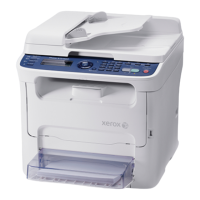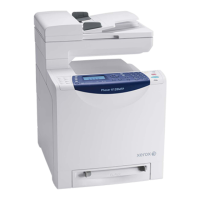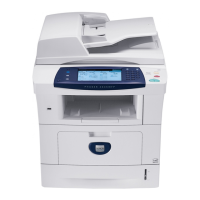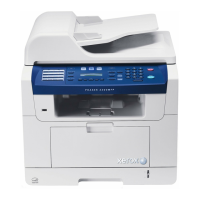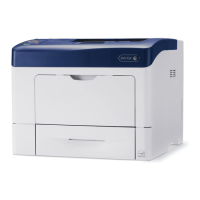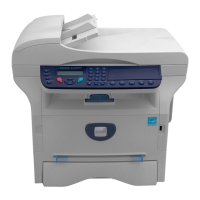2-102 Phaser 6180MFP Multifunction Printer Service Manual
Theory of Operation
■ Phase A – Call Establishment
In order for a fax to be established, both ends of the line must recognize
that the other end is a non-voice (Fax) terminal. Since G3 fax
communication is intended for a transmission over the conventional voice
network, a fax communication must be initiated via audible tones.
The sending side sends out a Calling Tone (CNG.1100Hz for 0.5 sec.),
which identifies itself as a fax terminal. Then, the receiving side responds
with a Called Station Identification (CED.2100Hz for 3 sec.) to identify
itself as an available fax terminal. Thus, a fax call is established between
the two terminals.
■ Phase B – Capability Negotiations
The receiving side presents all of the capabilities it has to offer by sending
out NSF/CSI/DIS signals. Then, the sending side responds with NSS/TSI/
DCS signals to declare what it has selected from the capabilities
presented by the receiving side.
The sending side sends out a training signal (TCF) to adjust the modem
to the maximum transmission rate available. Upon a successful reception
of TCF, the receiving side responds with Confirmation to Receive (CFR),
which indicates that the receiving side is ready for receiving image data.
In the event of an abnormal TCF reception, the receiving side responds
with Failure to Train (FTT), which requests retransmission of NSS/TSI/
DCS and TCF signals.
■ Phase C – Image Data Transfer
The sending side transmits the image data based on the parameters
agreed upon in Phase B. Also carried out are the signaling control
procedures including synchronization, error detection/correction, and line
supervision.
■ Phase D – Post-transfer Procedure
In the Post-transfer Procedure, the sending side checks its status after the
completion of Phase C and sends an appropriate signal to return the
session to the previous phases. When there are more pages to follow, the
sending side sends out Multi-Page Signal (MPS) and the session returns
to Phase C. When there are more pages to follow and the subsequent
page is to be sent in a different mode, the sending side sends out End of
Message (EOM) and the session returns to Phase B. The session
proceeds to Phase E only when the receiving side receives End of
Procedure (EOP) indicating that the sending side has completed
transmission of the entire document. Therefore, the session may show a
looped sequence such as ABCDCD...E, ABCDBCDBCD...E. etc.,
depending on the remainder of the document or the transmission
parameters for the subsequent page.
